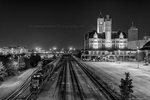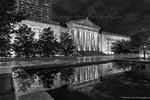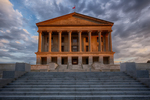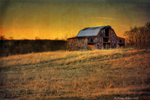Album: Nashville, TN Bridges
The Shelby Street Bridge was originally known as the Sparkman Street Bridge and was built one block south of Broadway, connecting Sparkman Street and Shelby Avenue.[2] The bridge was constructed at a cost of about $475,000. Another bridge called the Jefferson Street Bridge which was virtually identical to it was built at the same time. The Jefferson Street Bridge was opened a year after the Sparkman Street Bridge. The substructures of the bridges were light grey concrete, and the superstructures were made of steel that had been painted black. The bridge was the first in North America to have concrete arched trusses. The bridge was designed and construction was supervised by Howard M. Jones, the chief office engineer of the Nashville, Chattanooga and St. Louis Railway. The original architectural drawings as approved by Jones are archived at the Metro Transportation Offices. After twenty-five years of use, it became apparent that there was something wrong with the concrete on the Sparkman Street Bridge. The worn surfaces of the concrete were chipped away between 1927 and 1930 and replaced with gunite. Thirty years later, repair work had to be done again. The Standard Engineering Company of Albany, New York was hired to repair the weathered bridge. They subcontracted the steel work to the Nashville Bridge Company. During this repair time, the Jefferson Street Bridge was also repaired. In 1998 the Shelby Street Bridge was admitted to the National Register of Historic Places, due mainly to the unique truss design. Both the Shelby Street Bridge and the Jefferson Street Bridge were considered. The Jefferson Street Bridge was rejected because of its similarity to the Shelby Street Bridge and the fact that the Shelby Street Bridge was in better condition. The Jefferson Street Bridge was demolished in 1990 to make way for a new bridge that could handle more traffic State inspectors declared the bridge to be in "poor" condition in 1992, and the bridge was closed to vehicular traffic in 1998. The bridge was originally slated for demolition. However, due to aesthetic, architectural, and historical considerations, it was decided that it should be converted to a pedestrian bridge rather than be demolished. The success of the Walnut Street Bridge as a part of Chattanooga's urban renewal efforts was a major consideration in keeping the bridge. The bridge was refurbished and includes an elevator, ramps, and stairways. The bridge has a center lane that is fifteen feet across to accommodate bicycles. Originally it was thought that a trolley might use the center lane, but that idea was abandoned in favor of a bicycle lane. On each side of the bicycle lane are ten foot wide elevated boardwalk-style sidewalks. The bridge includes four scenic pedestrian overlooks that, in the metal of the railing, have artistic renderings of the history of life on the Cumberland River. The bridge is dramatically lit at night. The refurbished bridge is part of the Metro Nashville Greenway system, which is administered by the Parks Department. The Eastern terminus includes a pedestrian plaza with special landscaping and is very close to LP Field. The Western terminus comes out facing the Schermerhorn Symphony Center and is very close to the Country Music Hall of Fame and the Sommet Center. The refurbishment of the bridge cost in excess of $15 million and was done under the supervision and planning of the Tennessee Department of Transportation. A new bridge called The Gateway Bridge was built to handle the vehicle traffic that used to travel over the Shelby Street Bridge. CUMBERLAND RIVER PEDESTRAIN BRIDGE The 750' bridge will connect the Stones River Greenway at Two Rivers Park to the Shelby Bottoms Greenway and will become a critical link to a 22-mile greenway corridor. Pedestrians and bicyclists will be able to travel from the Percy Priest Dam to downtown Nashville and north to MetroCenter almost completely free from vehicular traffic. The bridge will also act as an alternative form of transportation connecting schools, parks, businesses and entertainment areas. The bridge connects 10 parks along the route - Hermitage, Heartland, Two Rivers, Shelby Bottoms, Shelby Park, East Bank, Riverfront, Morgan, Ted Rhodes and Looby.
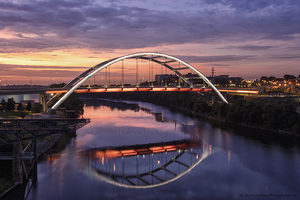 |
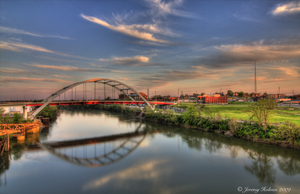 |
||
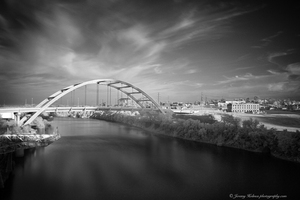 |
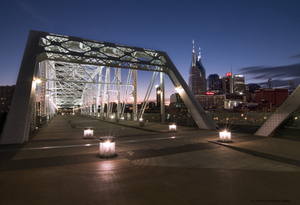 |
||
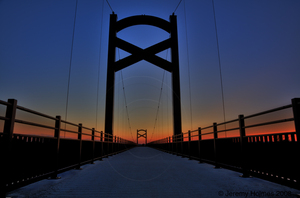 |
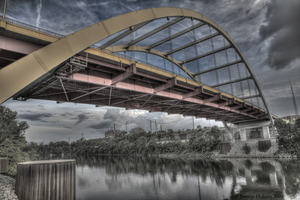 |
||
